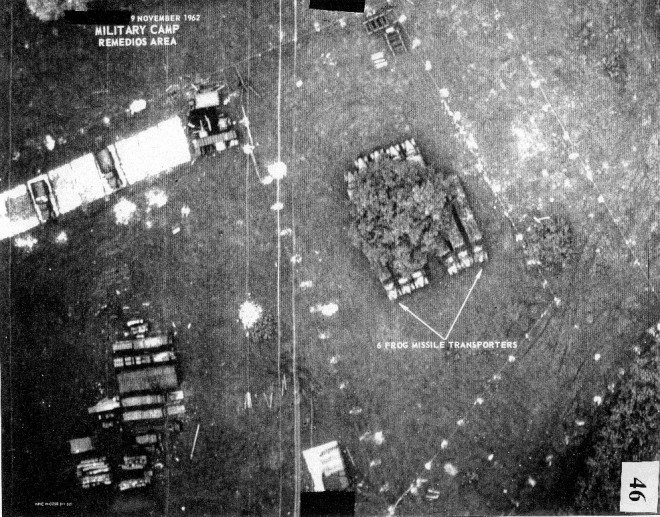On Oct. 25 1962 two unarmed and unescorted Navy photo-reconnaissance jets were speeding over the Cuban landscape on their way to photograph an intermediate-range ballistic missile site being constructed by Soviet technicians. The lead RF-8A Crusader was piloted by Lt. Cmdr. Tad Riley. His wingman, Lt. Jerry Coffee, flew sorties with the first VFP-62 low-level reconnaissance missions on Oct. 23, as part of the classified operation codenamed Blue Moon. Coffee spotted a military encampment and broke formation with his flight leader to get a closer to take pictures. His photographs disclosed a military threat unknown to Pentagon and the CIA analysts: Soviet tactical nuclear-capable Luna missiles. This evidence of battlefield weapons of mass destruction got submerged in the flood of intelligence reaching the president. Those forgotten missiles of the Cuban Missile Crisis could have triggered World War III.
Earlier, in response to a Soviet supplied military buildup in Cuba in mid-1962, Pentagon planners were refining two operational plans against Cuba: one a massive 500 sortie airstrike against missile and radar sites and MiG airfields; the other a 125,000-strong joint-force invasion. The latter apparently had no contingencies for facing tactical nuclear weapons, as Defense Secretary Robert McNamara revealed in his book In Retrospect, “. . . U.S. invasion forces would not have been equipped with tactical nuclear weapons.”
President John F. Kennedy was alerted to the secretly-installed Soviet medium-range ballistic missile threat on Oct. 16, the first day of the so-called “Thirteen Days” of the Cuban Missile Crisis. His response was not swift — days of consultation with his military and civilian advisers wore on — and, culminated in his Oct. 22 public announcement of a naval blockade of Cuba and demand for the removal of all offensive weapons. JFK, sobered by his top military brass’ assessment that a quick surgical airstrike to take out all the MiGs and missiles was not possible, struggled to find a diplomatic resolution to the crisis but kept his military options on the table.
Inexplicably, the CIA and the Joint Chiefs of Staff (JCS) reacted slowly to earlier U-2 high-altitude photos and Coffee’s low-level photographs clearly showing the build-up of coastal defenses including FKR-2 cruise missiles and medium-range Ilyushin Il-28 bombers, both with ranges capable of carrying nuclear bombs to the U.S. Fleet and Guantanamo Naval Base. In fact, as early as September, the Kremlin high command alerted its commander in Cuba they were shipping six nuclear bombs for the Il-28s and 12 “special” [two kiloton nuclear] warheads for the Lunas, which had a range of 25 miles. And more grimly, the Soviet Minister of Defense Rodion Malinovsky and Matvei Zakharov, chief of the general staff, gave local commanders authority “to make your own decision, and to use the nuclear means of the Luna, Il-28, or FKR-2 as instruments of local warfare for the destruction of the invaders of the Cuban territory and to defend the Republic of Cuba.”
Declassified documents now reveal that on Oct. 26 the JCS was focused on the airstrike and invasion plans, with major emphasis on taking out the ballistic missiles aimed at the United States, the Il-28s, MiGs, and the surface-to-air missiles surrounding the island. In a classic military failure of underestimating one’s enemy, the Pentagon was not deterred by the Defense Intelligence Agency’s warning that “. . . there is evidence of possible Soviet ground forces with modern [tactical nuclear weapons] equipment.” The JCS continued to recommend an invasion to the president.
Perhaps the earliest intelligence report to reach Kennedy reporting the presence of the Lunas was in a Oct. 27 CIA report — almost an afterthought it appears— warning: “Photography of Mission 5012 (Coffee and Riley’s photo mission) of 25 October confirmed the presence of a FROG (Free Rocket Over Ground—the US designation for the Luna) launcher in a vehicle park near Remedios.” Never a strong advocate for an invasion, Kennedy was running out of time and support for a nonmilitary resolution to the standoff.
Fortunately, the crisis was resolved on Oct. 28 when Chairman Nikita Khrushchev agreed to remove the offensive weapons, with Kennedy’s promise not to invade Cuba and to remove the blockade. Decades later, McNamara revealed that at the “height of the crisis, Soviet forces in Cuba possessed a total of 162 nuclear warheads, including at least 90 tactical warheads.” He also concluded that the Soviets and Cubans would have chosen to “use them rather than lose them.” A reader of this history is left to ponder if the first Luna fired against an American invasion force would also have been the first shot of World War III.





